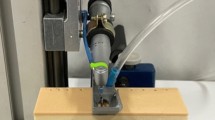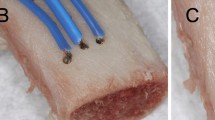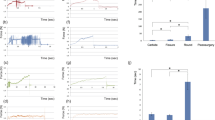Abstract
Objectives
The aim of this in vitro study was to evaluate osteotomy speed, heat development, and bone structure influence from osteotomies performed by various piezoelectric devices and insert tips. These devices and tips were compared among each other with regard to conventional rotatory and oscillating systems with special focus on the insert tip design and thickness.
Material and methods
The osteotomies were conducted on porcine ribs utilizing 12 different insert tips (straight and angulated) and three conventional systems. After time and temperature measurements, histological analysis was carried out. Light microscopy was used to evaluate the roughness of the osteotomic surface and to search for indications of thermal bone necrosis. A special software analyzing tool was employed to determine cutting width (mm) and debris (%).
Results
All piezoelectric tips created smooth cuts. Cutting widths in general were wider than the actual insert tip size with a tendency for narrow straight insert tips producing relatively wide osteotomies, whereas narrow angulated inserts produced relatively small osteotomies. None of the samples demonstrated distinct indication of necrosis. Overall, there was only a small amount of debris in all osteotomy gaps. Conventional rotatory saws were faster and created less heat compared to all tested piezoelectric systems. Straight tips proved faster osteotomy speed than angulated tips. Thin insert tips indicated to have a positive correlation to osteotomy time and performed faster than conventional microsaw. The average temperature rise was lower when using conventional systems, but critical exceeding temperatures were only observed in short-time exceptional cases. In general, temperature rise was less when using angulated inserts.
Conclusion
All tested tips are appropriate for bone surgery. Only small differences were found among the piezoelectric insert tips. Although conventional rotatory systems in general performed faster osteotomies, special designed and thin piezoelectric insert tips seem to have a positive influence on osteotomy speed. Ultimately, none of the tested devices or inserts combined all best features of speed, heat development, bone structure influence, and safety.
Clinical relevance
Narrow and straight piezoelectric insert tips demonstrated reduced osteotomy times. Nevertheless, a combination of conventional and piezoelectric systems in clinical practice might be the best way to work time-efficient, patient-oriented, and safe. The choice of instrument should be based on clinical experience of the user and should be evaluated individually depending on the case.















Similar content being viewed by others

References
Stubinger S, Stricker A, Berg BI (2015) Piezosurgery in implant dentistry. Clin Cosmet Investig Dent 7:115–124. https://doi.org/10.2147/ccide.s63466
Labanca M, Azzola F, Vinci R, Rodella LF (2008) Piezoelectric surgery: twenty years of use. Br J Oral Maxillofac Surg 46(4):265–269. https://doi.org/10.1016/j.bjoms.2007.12.007
Yaman Z, Suer BT (2013) Piezoelectric surgery in oral and maxillofacial surgery. Annals of Oral & Maxillofacial Surgery 1(1):5
Pereira CC, Gealh WC, Meorin-Nogueira L, Garcia-Junior IR, Okamoto R (2014) Piezosurgery applied to implant dentistry: clinical and biological aspects. J Oral Implantol 40 Spec No:401–408. doi:https://doi.org/10.1563/aaid-joi-d-11-00196
Vercellotti T (2000) Piezoelectric surgery in implantology: a case report—a new piezoelectric ridge expansion technique. Int J Periodontics Restorative Dent 20(4):358–365
Vercellotti T, De Paoli S, Nevins M (2001) The piezoelectric bony window osteotomy and sinus membrane elevation: introduction of a new technique for simplification of the sinus augmentation procedure. Int J Periodontics Restorative Dent 21(6):561–567
Torrella F, Pitarch J, Cabanes G, Anitua E (1998) Ultrasonic ostectomy for the surgical approach of the maxillary sinus: a technical note. Int J Oral Maxillofac Implants 13(5):697–700
Gruber RM, Kramer FJ, Merten HA, Schliephake H (2005) Ultrasonic surgery—an alternative way in orthognathic surgery of the mandible. A pilot study. Int J Oral Maxillofac Surg 34(6):590–593. https://doi.org/10.1016/j.ijom.2005.06.006
Vercellotti T (2004) Technological characteristics and clinical indications of piezoelectric bone surgery. Minerva Stomatol 53(5):207–214
Vercellotti T, Nevins ML, Kim DM, Nevins M, Wada K, Schenk RK, Fiorellini JP (2005) Osseous response following resective therapy with piezosurgery. Int J Periodontics Restorative Dent 25(6):543–549
Preti G, Martinasso G, Peirone B, Navone R, Manzella C, Muzio G, Russo C, Canuto RA, Schierano G (2007) Cytokines and growth factors involved in the osseointegration of oral titanium implants positioned using piezoelectric bone surgery versus a drill technique: a pilot study in minipigs. J Periodontol 78(4):716–722. https://doi.org/10.1902/jop.2007.060285
Leclercq P, Zenati C, Dohan DM (2008) Ultrasonic bone cut part 2: state-of-the-art specific clinical applications. J Oral Maxillofac Surg 66(1):183–188. https://doi.org/10.1016/j.joms.2005.12.050
Schlee M (2005) Ultraschallgestützte Chirurgie - Grundlagen und Möglichkeiten. Z Zahnärztl Impl:48–59
Horton JE, Tarpley TM Jr, Jacoway JR (1981) Clinical applications of ultrasonic instrumentation in the surgical removal of bone. Oral Surg Oral Med Oral Pathol 51(3):236–242
Sohn DS, Ahn MR, Lee WH, Yeo DS, Lim SY (2007) Piezoelectric osteotomy for intraoral harvesting of bone blocks. Int J Periodontics Restorative Dent 27(2):127–131
Jiang Q, Qiu Y, Yang C, Yang J, Chen M, Zhang Z (2015) Piezoelectric versus conventional rotary techniques for impacted third molar extraction: a meta-analysis of randomized controlled trials. Medicine (Baltimore) 94(41):e1685. https://doi.org/10.1097/md.0000000000001685
Barone A, Santini S, Marconcini S, Giacomelli L, Gherlone E, Covani U (2008) Osteotomy and membrane elevation during the maxillary sinus augmentation procedure. A comparative study: piezoelectric device vs. conventional rotative instruments. Clin Oral Implants Res 19(5):511–515. https://doi.org/10.1111/j.1600-0501.2007.01498.x
Lundskog J (1972) Heat and bone tissue. An experimental investigation of the thermal properties of bone and threshold levels for thermal injury. Scand J Plast Reconstr Surg 9:1–80
Eriksson AR, Albrektsson T (1983) Temperature threshold levels for heat-induced bone tissue injury: a vital-microscopic study in the rabbit. J Prosthet Dent 50(1):101–107
Delgado-Ruiz RA, Sacks D, Palermo A, Calvo-Guirado JL, Perez-Albacete C, Romanos GE (2015) Temperature and time variations during osteotomies performed with different piezosurgical devices: an in vitro study. Clin Oral Implants Res 27:1137–1143. https://doi.org/10.1111/clr.12709
Stacchi C, Berton F, Turco G, Franco M, Navarra CO, Andolsek F, Maglione M, Di Lenarda R (2016) Micromorphometric analysis of bone blocks harvested with eight different ultrasonic and sonic devices for osseous surgery. J Craniomaxillofac Surg 44(9):1143–1151. https://doi.org/10.1016/j.jcms.2016.04.024
Pandey RK, Panda SS (2013) Drilling of bone: a comprehensive review. J Clin Orthop Trauma 4:15–30. https://doi.org/10.1016/j.jcot.2013.01.002
Eriksson RA, Albrektsson T, Magnusson B (1984) Assessment of bone viability after heat trauma: a histological, histochemical and vital microscopic study in the rabbit. Scand J Plast Reconstr Surg 18:261–268. https://doi.org/10.3109/02844318409052849
Schweiberer L, Dambe LT, Eitel F, Klapp F (1974) [Revascularization of the tibia afterconservative and surgical fracture fixation]. Hefte Unfallheilkd 18–26
Simonetti M, Facco G, Barberis F, Signorini G, Capurro M, Rebaudi A, Sammartino G (2014) Bone characteristics following osteotomy surgery: an in vitro SEM study comparing traditional Lindemann drill with sonic and ultrasonic instruments
Rashad A, Sadr-Eshkevari P, Weuster M, Schmitz I, Prochnow N, Maurer P (2013) Material attrition and bone micromorphology after conventional and ultrasonic implant site preparation. Clin Oral Implants Res 24:110–114. https://doi.org/10.1111/j.1600-0501.2011.02389.x
Khambay BS, Walmsley AD (2000) Investigations into the use of an ultrasonic chisel to cut bone. Part 2: cutting ability. J Dent 28(1):39–44
Rullo R, Addabbo F, Papaccio G, D'Aquino R, Festa VM (2013) Piezoelectric device vs. conventional rotative instruments in impacted third molar surgery: relationships between surgical difficulty and postoperative pain with histological evaluations. J Cranio-Maxillofac Surg 41(2):e33–e38. https://doi.org/10.1016/j.jcms.2012.07.007
Waechter J, Leite FR, Nascimento GG, Carmo Filho LC, Faot F (2016) The split crest technique and dental implants: a systematic review and meta-analysis. Int J Oral Maxillofac Surg 46:116–128. https://doi.org/10.1016/j.ijom.2016.08.017
Boa K, Varga E Jr, Pinter G, Csonka A, Gargyan I, Varga E (2015) External cooling efficiently controls intraosseous temperature rise caused by drilling in a drilling guide system: an in vitro study. Br J Oral Maxillofac Surg 53(10):963–967. https://doi.org/10.1016/j.bjoms.2015.07.013
Khambay BS, Walmsley AD (2000) Investigations into the use of an ultrasonic chisel to cut bone. Part 1: forces applied by clinicians. J Dent 28(1):31–37
Blus C, Szmukler-Moncler S (2006) Split-crest and immediate implant placement with ultra-sonic bone surgery: a 3-year life-table analysis with 230 treated sites. Clin Oral Implants Res 17(6):700–707. https://doi.org/10.1111/j.1600-0501.2006.01206.x
Geha HJ, Gleizal AM, Nimeskern NJ, Beziat JL (2006) Sensitivity of the inferior lip and chin following mandibular bilateral sagittal split osteotomy using Piezosurgery. Plast Reconstr Surg 118(7):1598–1607. https://doi.org/10.1097/01.prs.0000232360.08768.de
Metzger MC, Bormann KH, Schoen R, Gellrich NC, Schmelzeisen R (2006) Inferior alveolar nerve transposition—an in vitro comparison between piezosurgery and conventional bur use. Journal of Oral Implantology 32(1):19–25. https://doi.org/10.1563/1548-1336(2006)32[19:IANTIV]2.0.CO;2
Funding
The work was supported by the Department for Oral and Cranio-Maxillo and Facial Plastic Surgery, University of Cologne, Cologne, Germany.
Author information
Authors and Affiliations
Corresponding author
Ethics declarations
Conflict of interest
Surgical devices were provided by W&H Germany. D. Rothamel has received speaker honorariums from W&H. The other authors declare that they have no conflict of interest.
Ethical approval
This article does not contain any studies with human participants or animals performed by any of the authors.
Informed consent
For this type of study, formal consent is not required.
Additional information
Publisher’s note
Springer Nature remains neutral with regard to jurisdictional claims in published maps and institutional affiliations.
Rights and permissions
About this article
Cite this article
Noetzel, N., Fienitz, T., Kreppel, M. et al. Osteotomy speed, heat development, and bone structure influence by various piezoelectric systems—an in vitro study. Clin Oral Invest 23, 4029–4041 (2019). https://doi.org/10.1007/s00784-019-02838-8
Received:
Accepted:
Published:
Issue Date:
DOI: https://doi.org/10.1007/s00784-019-02838-8



